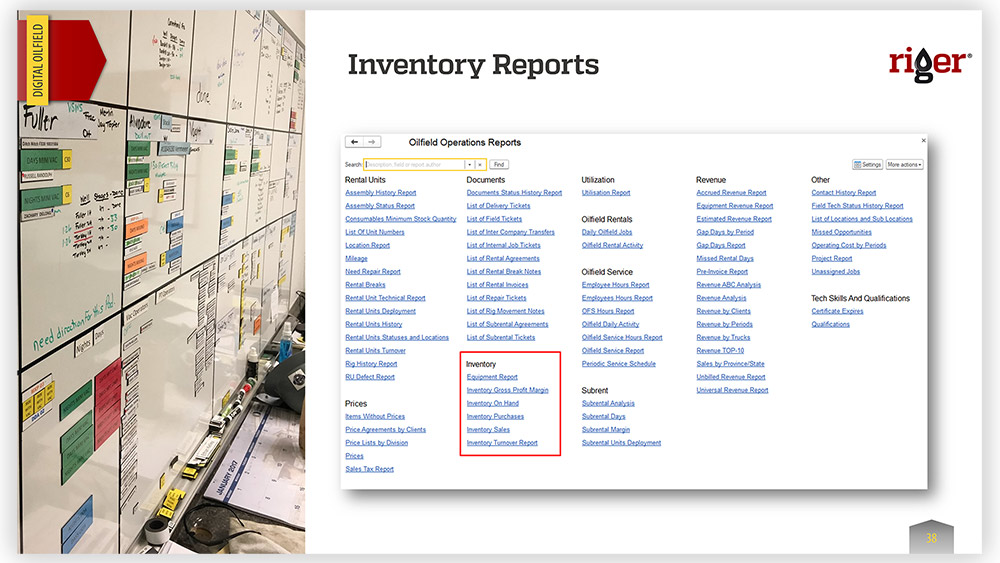If the title caught your eye and you are reading this, I am willing to assume that either you, or someone you know closely, are familiar with the hurdles inventory management can lead to if done poorly and the value it can bring to the table when undertaken properly. It would be even more rewarding to know that my aforementioned assumption is incorrect and your willingness to get acquainted with this material is born out of genuine curiosity or pure interest in the subject.
Inventory management is not and has never been an easy task, especially, for example, if you are running a rental business, in the Oil & Gas Industry with a fleet that can range from a couple dozens to upwards of few hundreds, or maybe even thousands of items. This is a close-to-perfect example of a company to talk about when it comes to inventory management. There are so many variables, so many possible scenarios that at times it can get confusing and frustrating.
The more the quantity you have in stock, the harder the management process is likely to become, which will lead to a growing demand of resources necessary to be spent on it, which inevitably will slow down the growth rate of your business. This factor, singlehandedly, can be the dealbreaker when it comes to being (at least) competitive in today’s market.
Typical steps involved in the process
I would like to break it down to bits what I imply under inventory management particularly in this article, so you and I are on the same page.
It will all obviously start with the purchase of an asset and the addition of it to your fleet and will end in either sale or disposal of it, due to several different reasons. Meanwhile there are (or rather can be) a lot of steps involved in the lifecycle of every single asset, such as:
- Deployment, return and tracking
- Repairs (on site, in shop, third party)
- Inspections (pre/post-delivery, after return, etc.)
- Maintenance (preventive, scheduled, etc.)
- Movement between client locations
- Internal transfers from shop to shop
- Reserving of units for future deployment
- Assigning backup units for deployed ones in case of failure
- And so on
Each and every single one of the above-mentioned steps is a subject for its own article rich with relevant information. Each one of them represents a domain, that if utilized, will need to follow a precisely defined and well tested process to be successful.
The bottom line is – it will require knowledge, resources and the right tools to do it correct and to set you apart from the competition.
Issues that can be considered common
I think you will agree with me – saying that in time, the probability, that something can (read will) go wrong is fairly high enough. This is especially true in a fluctuating environment that is under the influence of dozens of variables (Oil & Gas?!).
After all, no one has cancelled Murphy’s Law…
Anyways, let me continue my thoughts by emphasizing just a few of the most common problems faced while managing inventory / physical assets:
- Inability to track the assets correctly and consistently
- Damaged equipment
- Lost/stolen equipment
- Forgotten steps in the process (for example pre-delivery inspection, or QC after repair)
- Having no, or incomplete history about any single item
This list can go on and on. The point is – each one of the issues mentioned will undoubtedly lead to loss – be it loss of revenue, loss of physical assets and even in some, very unpleasant cases – loss of reputation. And it is unacceptable for a successful business.
The HOW-TO’s of the process
Obviously, each business will have its own process when it comes to inventory management. Some will excel at it; some will fail miserably. Some will waste a lot of time and resources and still be unsuccessful, some will invest in research, evaluation and planning, then end up using the correct tools (by qualified personnel) which will simplify the process as much as possible and allow it to be utilized to its full extent in a cleverly controlled environment.
But in every single scenario there would also be external factors that will need to (and must be) considered: The market you are in, the size of your business and the resources you have, the competitors and their KNOW-HOW’s, other factors that can either somehow be an obstacle for you or become a competitive advantage.
For example you can lean on the “pen-to-paper” method while managing your inventory of under 30 physical pieces and be quite successful.
Or you can utilize Excel spreadsheets, and do more advance logging/tracking of the fleet of maybe couple hundred units (?).
Or you can even go to the next level and implement an Operations Management Software suit, that will have a bunch of useful features, and will most definitely give you the edge over the competitors.
It all depends on several factors and is up to each business owner to make the correct choice of the process/personnel/tools.
One thing though is very clear in today’s reality – going digital is the future!
Having the correct
oil and gas software suit acting as a well-honed tool in the hands of the qualified user will drastically simplify the complicated process of inventory management. Some tasks can be scheduled, some can be automated… All that is needed is an oversight.

